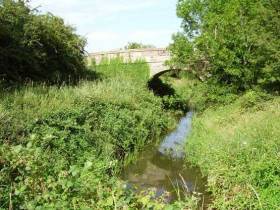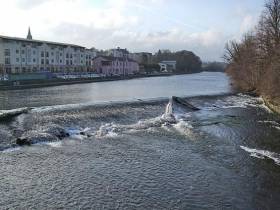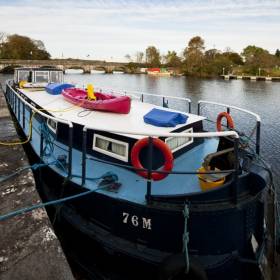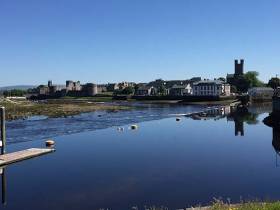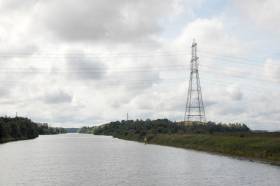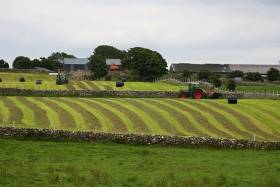Displaying items by tag: inland waters
Ministers Announce New Ulster Canal Forum
#UlsterCanal - Minister for Arts and Heritage Heather Humphreys joined Northern Ireland Minister for Infrastructure Chris Hazzard yesterday (Monday 15 August) to announce the establishment of a new Ulster Canal Advisory Forum.
The purpose of the forum is to consider options for advancing the long-delayed inland waterways project, which finally saw works begin last year, and to examine possible funding mechanisms both already existing and from other sources.
The forum will also have regard to the review of the Ulster Canal being taken forward by the Northern Ireland Executive and the Irish Government as set out in A Fresh Start – The Stormont Agreement and Implementation Plan.
Membership of the forum will consist of two elected members and one official respectively from Monaghan County Council, Cavan County Council, Fermanagh and Omagh District Council as well as senior officials from the Department of Arts, Heritage, Regional, Rural and Gaeltacht Affairs, the NI Department for Infrastructure, and Waterways Ireland.
Interested stakeholders from other organisations will be invited to attend meetings of the forum as appropriate.
Announcing the forum, Minister Humphreys said: “Having obtained Government approval for the commencement of Phase 1 of the Ulster Canal restoration project from Upper Lough Erne to Castle Saunderson, I am anxious to build on this momentum and to plan for the further development of this important resource which is so critical for the border region.
"This forum, which will include key stakeholders along the Ulster Canal route, will be a positive dynamic in advancing the project.”
Minister Hazzard added: “I am keen that development of the Ulster Canal is undertaken in partnership with local councils and communities. By working together we can help unlock the tourism potential of the entire region and maximise all available funding opportunities.
"The commitment made in the Fresh Start agreement clearly signals our shared interest in moving this project forward.”
Emergency Works Required At Fermoy Weir
#FermoyWeir - Inland Fisheries Ireland (IFI) is consulting with Cork County Council regarding emergency works required at Fermoy Weir.
Low water levels, damage to the weir cap below the bridge and a strong run of salmon on the Munster Blackwater have resulted in large numbers of migrating fish becoming trapped below the weir.
IFI protection officers are closely monitoring the situation to minimise the risk to migrating fish. It's anticipated that the council will begin work to create a natural channel to direct fish towards the fish ladder.
IFI will advise stakeholders on the Munster Blackwater once the scope of works and timeframe is agreed.
Irish Water Prosecuted Over Midlands River Fish Kill
#FishKill - Inland Fisheries Ireland (IFI) has successfully prosecuted Irish Water over a chemical discharge on 18 August last year that causing a significant fish kill on a tributary of the Tullamore River.
At a sitting of Portlaoise District Court on Friday 15 July, Judge Catherine Staines heard evidence from Michael Fitzsimons, a senior fisheries environmental officer with IFI, that following a pollution report received from Irish Water, IFI carried out a detailed investigation on the Clodiagh River.
Over 3,000 fish mortalities were estimated over a 4km stretch of the river, consisting predominantly of trout along with other species such as salmon, lamprey, minnow and stoneloach.
The fish kill was as a direct result of a chemical discharge from an accident at the Irish Water plant in Clonsalee, Co Laois. Irish Water entered a guilty plea.
Judge Staines directed Irish Water to pay IFI’s legal costs of €5,016 and to cover the full cost of the rehabilitation works to be carried out downstream of the incident area. A development plan will be formulated by IFI in the coming weeks.
The judge did not impose a fine on the basis that it would be the Irish taxpayer paying for the incident. She also instructed Irish Water to carry out a full review of its Waste Water Treatment Plants (WWTP) and provide a report to her by 21st July 2017.
Judge Staines stated that she did not want to see an incident like this happening again.
“This was a serious pollution incident which will take a considerable number of years for the river to recover," said Amanda Mooney, Shannon River Basin District director with IFI.
"I am pleased with the outcome of the case and the provision for vital rehabilitation works to assist fish stocks to recover naturally.”
Judge Staines adjourned the case until 21 July 2017 to allow sufficient time for the rehabilitation works and WWTP review report to be concluded.
In other news, submissions are open for the consultation on plans to phase out fish farming at three of four IFI facilities it currently operates around Ireland.
As previously reported on Afloat.ie, operations in Roscrea, Co Tipperary; Cullion in Mullingar, Co Westmeath and Lough Allua in West Cork are affected by the restructuring plan.
Facilities at Cong in Co Mayo will be retained or research and stocking purposes, but rainbow and brown trout will no longer be farmed for sale.
Submissions should be made in writing before 5pm on Friday 19 August to [email protected] or Fish Farm Consultation, IFI, 3044 Lake Drive, Citywest Business Campus, Dublin D24 Y265.
#Rowing - The Carrick-on-Shannon Rowing Regatta will be held on Sunday 31 July on a 400m stretch of the waterway immediately south of the town bridge.
Hundreds of spectators and competitors are expected at the event, one of the final rowing events of the season, which is supported by Waterways Ireland through its sponsorship programme.
Events begin at 8am and will run till around 6pm. Craft wishing to make a through passage will be facilitated every two hours (approx) during the course of the regatta. Mooring restrictions will apply in Carrick-on-Shannon to facilitate the regatta.
In the interest of marine safety and to facilitate the laying of the competition course, access to the floating moorings will be restricted in the run-up to and during the event itself.
Only vessels of an overall length of 22ft/6.8m or less will be permitted on the floating jetties from Friday 29 to Sunday 31 July. Vessels berthed from Friday 29 July at 4pm will be required to remain in place until racing finishes on the Sunday evening.
The floating jetties will be closed off during this time and no vessels should approach as the entrance to the berths will be closed off and manoeuvring room will be severely restricted due to the proximity of the course. Access to the floating jetties will be monitored from Monday 25 July.
Masters are advised to proceed at slow speed and with due caution and to take note of advice from course marshals when passing through the area.
Further information can be had by contacting the Waterways Ireland inspectorate at +353 (0)87 985 2324 or North Shannon operations at +353 (0)71 96 50787.
#InlandWaters - More than 15 of Ireland's unique and hugely significant heritage barges – the Big Boats – are touring the Shannon Blueway, Lough Allen and the North Shannon from this Saturday 23 July till Saturday 6 August.
Organised by the Heritage Boat Association, a programme of public events and activities is planned in conjunction with Waterways Ireland and the communities of Drumshanbo and Leitrim village.
The first activity in the programme takes place on the morning of Friday 29 July as a cargo of coal is delivered by miners from the Arigna mines to a fleet of 12 heritage cargo boats waiting at Drumshambo lock on the Lough Allen Canal.
The public will be able to watch the loading from 10.30am and walk the Shannon Blueway from Drumleague Lock to Battlebridge lock with the boats as they travel along the canal to Acres Lake.
Walkers can also join with the boats at Drumhauver Bridge or Drumleague Lock from 11.30am and walk the rest of the way to Battle Bridge with the Big Boats.
On Saturday 30 July, Leitrim village will host the boats with a festival of music and fun. All are invited to come along and learn about the heritage boats – the same commercial barges that once carried cargos all across the inland waterways of Ireland.
Activities begin at 2pm with talks in Leitrim Village Community Centre and will be followed by a music and a free BBQ sponsored by the Barge Steakhouse. Visitors can come to look at the boats at the Apartment Narina north of Leitrim Village bridge.
The two week trip concludes with a visit to Drumsna on 5-6 August.
The Heritage Boat Association is celebrating the North Shannon navigations and in particular the Lough Allen Canal, which was built almost 200 years ago to carry Arigna coal to the main Shannon navigation.
The Big Boats were the juggernauts of their day and the canals were the highways on which the commerce of the nation depended.
The skippers and crews of the heritage boats are particularly interested in meeting with families who would have had friends or relations who worked on the navigation when it was a commercial waterway.
Full details of the trip and the Heritage Boat Association are available on their website HERE.
Updates On Inland Waterways Summer Works & Closures
#InlandWaters - Waterways Ireland advises that remedial works have commenced on the stretch of the Shannon Navigation between Limerick City and Parteen Weir after significant storm and flooding damage over the winter.
The closure had caused some consternation within the boating community as it effectively excluded Lough Derg sailors from this summer's WIORA races, and threatened to hit maritime revenues in Limerick.
But it was announced recently that design options had been advanced to provide for works to be completed this month.
It's believed that works on the affected infrastructure will be completed by the week beginning Monday 25 July. Prior tooth time, a schedule of opening times will be published for Sarsfield's Lock.
In other inland waterways news, the Barrow Line of the Grand Canal has been closed since Monday 11 July until forth notice due to a culvert collapse between Locks 22 (Glenaree Bridge) and 23 (Spencer Bridge). Further notice will be issued once the damage has been assessed.
Meanwhile, on the River Bann, Carnroe Lock has been closed for emergency repair works, which are expected to be completed within the next two weeks.
There's better news on Upper Lough Erne, however, as the public mooring jetty and slipway at Carrybridge is now open, with the exception of the pump-out facility.
Loughrea Firm Convicted Over Cavan Fish Kill
#FishKill - A Loughrea business was convicted over pollution discharge into the Laragh River in Co Cavan, causing a major fish kill between 12-14 August last year.
In addition to the fine of €4,000, Glan Agua was directed to pay legal costs and expenses to Inland Fisheries Ireland (IFI) to a total of €63,352.94 including €59,262.94 towards appropriate mitigation measures.
Glan Agua was prosecuted by IFI following investigations into a fish kill on the Laragh River after the discharge of chorine from Knockataggert drinking water treatment plant.
At a sitting of the District Court held at Cavan Courthouse on Thursday 23 June, Judge Denis McLoughlin heard evidence from Ailish Keane, senior fisheries environmental officer with IFI, that IFI carried out detailed investigations on the Laragh River over a number of days after a tip-off from the public.
It was established that more than 3,000 fish – including brown trout, minnow, stone loach, eel and stickleback – had been killed over a distance of 6km from a surface water outfall at the Clifferna Bridge to just below Drumgur Bridge.
Giving details of sampling and analysis undertaken, Keane confirmed the discharge from the surface water pipeline to the Laragh River was characterised by seriously elevated levels of sodium hypochlorite, otherwise known as chlorine.
Keane said that on the morning of 13 August, she visited the Knockataggert drinking water treatment plant at Clifferna, Co Cavan. She noted that there was a serious fish kill and that there had been a chorine on the premises that had subsequently discharged into a surface water pipe that later flows directly into the Laragh River.
On instruction, staff from Glan Agua immediately completed the clean-up of the discharge and prevented all remaining effluent residues from entering the watercourse. Glan Agua staff were found to be fully co-operative at all times during the investigation.
The legal representative for Glan Agua, who told Judge Mcloughlin their client pleaded guilty in the matter, noted his client’s pristine record prior to this incident. He said that a director of the company was present in court and the employee who presided over the plant on the date the incident took place had been severely reprimanded.
Extensive evidence was given by Keane regarding the extent of investigations undertaken as a result of this significant pollution incident. The court was told it would take years for the river to regenerate itself to the condition it was in previous to the incident. Judge McLoughlin stated he could not stress the seriousness of the situation enough prior to handing down the sentence.
IFI has a confidential hotline number to enable members of the general public to report incidents – 1890 34 74 24 or 1890 FISH 24. This phone line is designed to encourage the reporting of incidents of illegal fishing, water pollution and invasive species.
#InlandWaters - Waterways Ireland has warned masters and users of Ireland's inland navigations of the dangers associated with overhead power lines.
In particular, sailing vessels, sailing dinghys and workboats with cranes or large air draughts should take extra care around any overhead cables.
Vigilance is required especially in the vicinity of slipways and dinghy parks, while voyage planning is a necessity in order to identify the location of overhead lines crossing the navigations.
If the vessel or its equipment comes in contact with an overhead power line, do not attempt to move the equipment or a person if either is still in contact with or close to the cable, as the conductor may still be live or re-energise automatically.
Maintain a five-metre clearance if possible, and prevent third parties from approaching you or your vessel because of the risk of arcing.
Contact the emergency services for assistance: the ESB Networks emergency number is (+353) 1850 372 999 and Northern Ireland Electricity Networks is (+44) 0800 616 817.
Those engaged in angling are also reminded that a minimum ground distance of 30 metres should be maintained from overhead power lines when using rod and line.
#Pollution - Inland Fisheries Ireland (IFI) has issued an appeal to all farmers to be vigilant when harvesting silage and spreading slurry to avoid water pollution.
Silage operations are ongoing all summer and silage effluent has the potential to cause devastating pollution in streams and rivers. Silage effluent is one of the most polluting substances to threaten the environment and can cause massive fish kills if it enters a watercourse.
Slurry spread on grassland over the summer months can also wipe out fish and invertebrate life if allowed to enter a stream. Water levels in streams and rivers are low in the summer months and have less dilution capacity, so are particularly vulnerable to pollution at this time.
“The fisheries service is appealing to all farmers and contractors to be careful that no silage effluent is allowed to run off into drains or watercourses," said Dr Greg Forde, head of operations at IFI.
"Round bales are the most environmentally friendly way to store silage. However, if a silage pit is used, it must be properly lined to prevent leakage.
“Good farmyard management will help to prevent accidental run-off and protect the local environment. Slurry spreading should only be carried out in dry weather, and not when heavy rain is forecast. It should never be spread close to a watercourse, and tanks should never be cleaned beside a stream or river.
Dr Forde addd that IFI “is grateful to the farming community for its co-operation at this busy time of year, and for its assistance in maintaining a clean and healthy environment in our lakes and rivers.”
IFI has a confidential hotline number to enable members of the general public to report incidents of water pollution, fish kills and illegal fishing or angling at 1890 34 74 24 or 1890 FISH 24.
Waterways Ireland Docklands Summer Festival This Weekend
#InlandWaters - The Waterways Ireland Docklands Summer Festival takes place this weekend 21-22 May with a wide array of activities for all.
Water-based experiences include kayaking, paddle boarding and barge rides, as well as the opportunity for the young and old to try their hand at a range of interesting water sports.
If you'd prefer to stay dry, events for land-lubbers include water golf off the jetty or the rubber duck race.
The festival promises a hive of activity across the Docklands, with entertainment and family fun guaranteed. Find out more HERE.
This Saturday 21 May also sees the Waterways Ireland Loughfest take place at the Fermanagh Lakeland Forum in Enniskillen.
The annual extravaganza, organised by Fermanagh and Omagh District Council, promises to be a fun-packed day for all the family, with a range of events taking place on Lough Erne and the Broadmeadow from 12 noon till 4pm. Details are HERE.



























